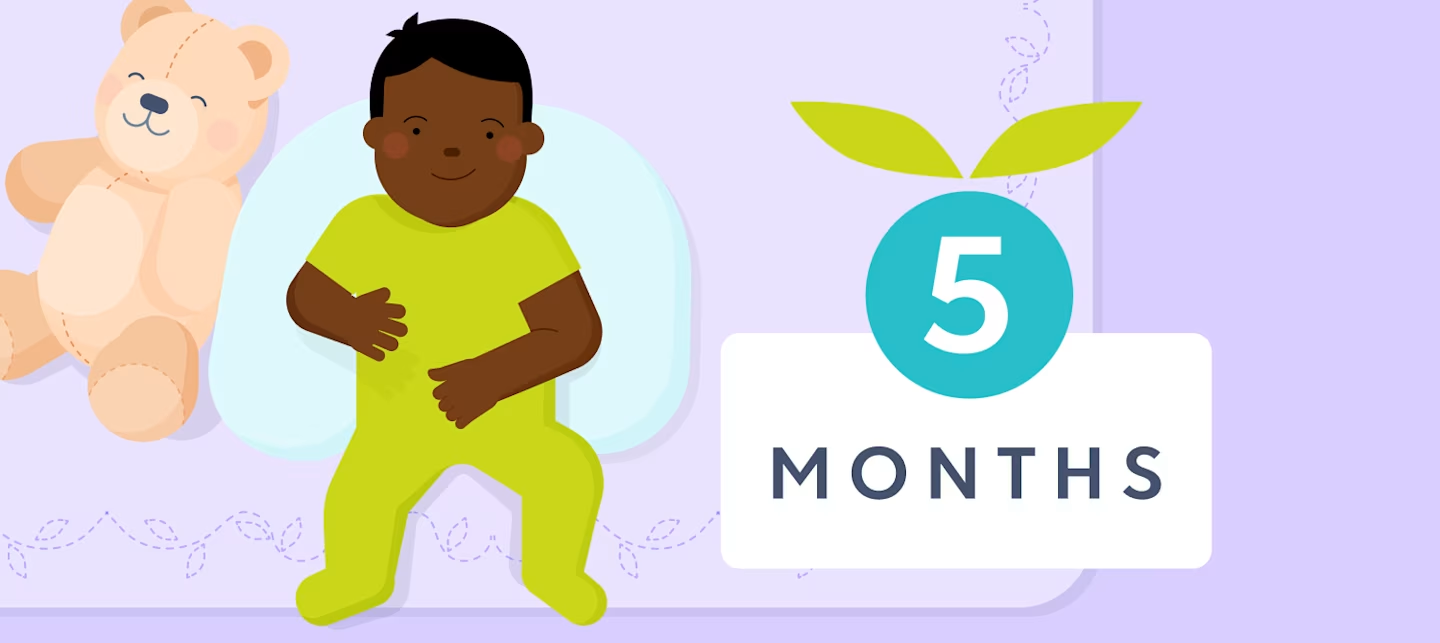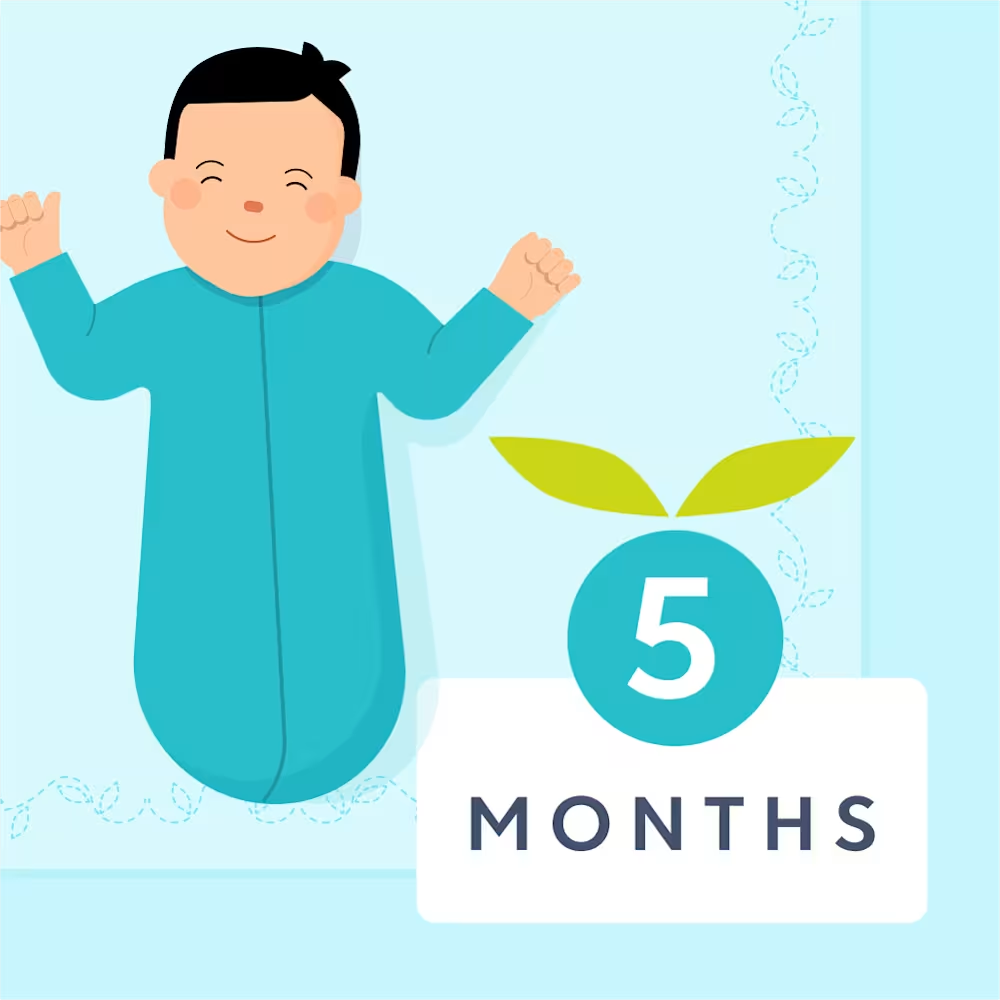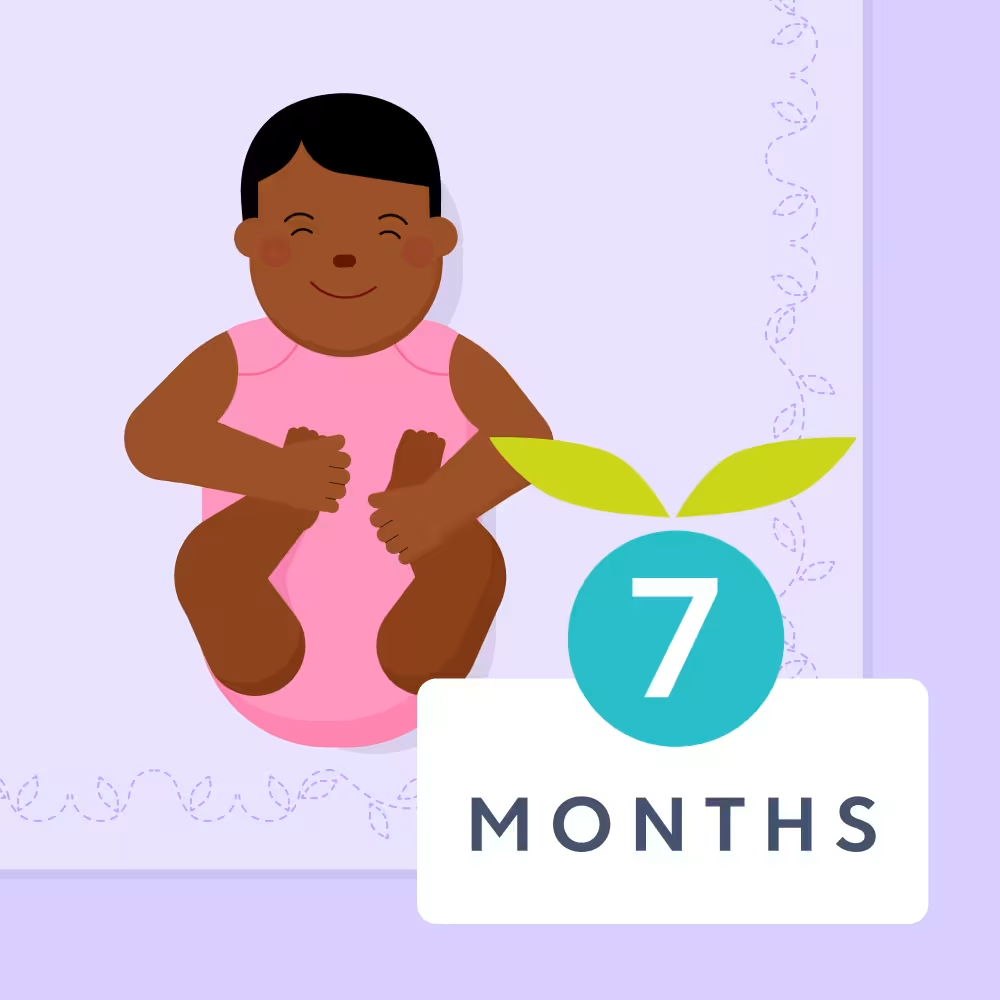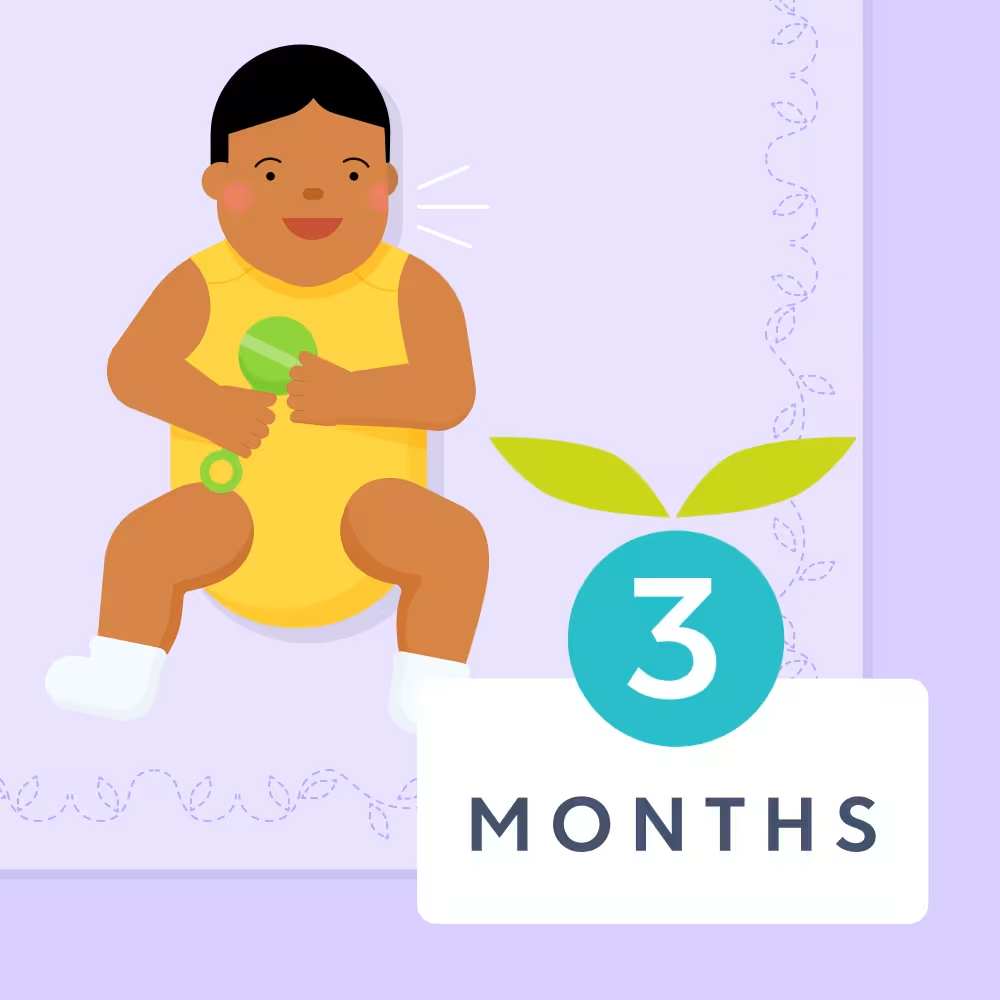5 month old baby milestones: Development, growth, speech, language
Updated Dec 10, 2025

At 5 months, babies are working on exciting skills like rolling over, sitting up with support, babbling, and engaging with toys. They’re also able to express emotions a little better through sounds, smiles, and other facial expressions. You’ll probably find yourself taking pictures and videos of your little one even more at this age to capture these big changes!
Have questions about milestones at 5 months?
In this article, we’ll take you through the milestones you can expect from 22 - 26 week old babies, give you a handy 5 month old development checklist, and provide useful tips to help ensure your little one is learning and growing as much as possible.
Editor's note
When we discuss babies and development at Huckleberry, we use their adjusted age (vs. actual age). Not all babies will reach 5 month old milestones simultaneously — and that’s normal. There’s a wide spectrum when it comes to how fast babies grow and develop. While many infants do reach these milestones between 22 and 26 weeks, this isn’t always the case. If you have any concerns or questions about your child’s development, reach out to their pediatrician.
Table of Contents
5 month old baby milestones at a glance
Development:
Between 22 - 26 weeks, babies often practice independent movement in the form of rolling over from back to tummy and tummy to back. Expected 5 month old gross motor milestones also include sitting with support along with kicking and wiggling their limbs intentionally.
When it comes to 5 month old language development, it’s all about babbling. Expect to hear plenty of “gaga” and “goo” from your cute baby! Babbling will also usually be accompanied by plenty of coos and smiles too. These early exchanges are setting the foundation for speech development down the road.
Sleep:
At 5 months, around 14.5 hours of sleep over a 24-hour period. This might look like 11 - 12 hours at night and 2.5 - 3.5 hours during the day spread out over 3 - 4 naps. Keep in mind these are rough estimates and it’s best to keep an eye on your little one’s mood and energy levels to assess their sleep needs. Some babies have higher or lower sleep needs and their day may look a little different.
When it comes to daytime sleep, most babies taking 4 naps a day can stay awake about 1.5 - 2.5 hours. Once they transition to 3 naps a day, this wake window will typically increase to closer to 2 - 3 hours. There’s often a transition period while your baby adjusts to taking one fewer nap per day so don’t be surprised if some days your little one takes 4 naps and some days they take 3 for a while. While the nap transition might make it a little hard to plan your day, rest assured it’s temporary.
You may notice your 5 month old is experiencing sleep changes after their sleep cycles and stages change around 3 - 4 months. The “” occurs when their sleep architecture matures and they begin to sleep in stages of light and deep sleep, similar to an adult. After this, it’s common to see short naps and more frequent wakings overnight. So don't fret, it's normal!
Feeding:
At this age, babies typically . This might look like 4 - 6 feedings totaling around 22 - 28 oz of formula or breast milk in a 24-hour period. A good way to tell if your 5 month old is getting enough calories per day is by checking to see that they have 4 - 6 wet diapers per day. This is typically a good indication that your baby is hydrated and properly fed.
Solids are also on the horizon too! While previous recommendations have suggested starting your baby on oatmeal at 4 months, the American Academy of Pediatrics [] currently recommends waiting until 6 months of age to introduce solid foods.
At 5 months, your baby might be showing signs of readiness for solids like bringing objects to their mouth, showing interest in solid food, improved head and neck control, and being able to sit unassisted with support. These are all important indicators that your little one is developmentally ready to consume food other than breast milk or formula.
Growth:
Typically a baby’s birth weight doubles by 4 - 5 months [2]! Weight gain is usually around 1 - 1.25 pounds between 5 - 6 months. Your little one’s height will likely increase by .5 - 1 inch this month. Their head will likely grow around .5 inches too.
Note that it can be normal for your little one to grow more or less than this between 22 - 26 weeks. At well-baby visits, your child’s doctor will chart their height and weight to check that they’re growing at a regular pace and can pinpoint any trends that need attention. Typically well-child visits occur at 4 and then 6 months, but if you have concerns about your baby at 5 months, consult their pediatrician.
5 month development milestones
Physical development
Gross motor skills
Rolling over: Your baby is likely working on rolling over at 5 months. By 6 months [], most little ones can roll from front to back as well as back to front. Rolling is an exciting gross motor milestone that marks the first time your baby can move their whole body independently and purposefully. However, rolling babies can also make it tricky to change diapers on a changing table or elevated surface. They move fast! You might consider moving diaper changes to the floor at this age.
If you haven’t stopped swaddling your baby already, the American Academy of Pediatrics [] recommends that you stop as soon as they show signs of rolling in order to keep your baby safe while they’re sleeping.
Wiggling and kicking: Look at those arms and legs go! Between 22 - 26 weeks, you’ll probably start to see your little one wiggle and kick more purposefully.
Sitting: Babies at 5 months likely aren’t sitting independently because they’re still developing the necessary core, neck, and head strength. Instead, they might be practicing sitting with some support [] (with pillows or propped up in your lap) and possibly using their hands for balance. Most babies aren’t able to sit up on their own until 7 - 9 months.
Fine motor skills
Reaching and grabbing: Fine motor skills between 4 - 5 months [] include reaching and grabbing objects with both hands due to improved hand-eye coordination. They’re also likely touching or banging items on a hard surface.
At 6 months, little ones are usually able to reach for an item with one hand, shake a rattle, and use all of their fingers at the same time (called a “raking grasp”) to pick up a small object. This is usually a good age to make sure your child’s play space is free from small objects that could be choking hazards.
Speech development
Babbling: Get ready to take a lot of videos of your baby saying “baba”, “goo,” and “gaga.” [] Typical 5 month old language development includes being able to make these simple sounds. By 6 months, they’re typically able to make single-syllable sounds like “da,” “ma,” and “ba.” They’ll often use these sounds to get your attention. There will be plenty of coos and gurgles at this age too!
Raspberries: Believe it or not, blowing raspberries [] is a milestone that helps set the foundation for speech! Most babies are able to make these silly sounds with their mouths by 6 months, so your baby may start between 22 - 26 weeks.
Visual development
Colors and patterns: 5 month olds might be more interested in colors and patterns now that they’re able to tell the difference. [] Complex patterns and shapes are also more visually interesting to infants at this age.
Focus: There’s so much to take in when you’re tiny! Between 22 - 26 weeks, you might notice your little one staring intently [] at a toy or their reflection. They can also maintain eye contact [] better now, especially with familiar people during exciting interactions like singing and playing peek-a-boo.
Social development
Emotional development
Expressing emotions: Between 4 - 6 months, most babies are able to make different sounds to express different emotions []. They’re starting to be able to show what they want through babbling, movements, facial expressions, and smiles.
Games: 5 month old emotional development means your little one might be interested in playful interactions now. Starting around 4 - 6 months, [] games like peek-a-boo and pat-a-cake can inspire them to vocalize and maintain eye contact with you.
Toys: At this age, babies likely enjoy playing with toys that have varied textures []. Children are exploring so much with their hands and mouths at 5 months!
5 month development milestones checklist
Keep in mind babies don’t all learn and grow at the same rate. While most children will hit these milestones by 22 - 26 weeks, this might not always be the case. However, if you are concerned about your child’s growth or developmental delays when it comes to 5 month old milestones, reach out to their healthcare provider.
Practice rolling skills
Move and wiggle arms and legs purposefully
Sit up with support
Reach and grab objects with both hands
Bang item on a hard surface
Babble sounds like “baba”, “goo,” and “gaga”
Blow raspberries by 6 months
Focus on colors and patterns
Stare intently at toys
Maintain eye contact for a longer period
Express emotions through different sounds
Interest in social games like peek-a-boo
Enjoy interacting with toys, especially with varied textures and colors
What are 5 month old development red flags?
Every baby develops at their own pace and that's expected. That said, there are a few signs at this age that may warrant checking in with their pediatrician, to rule out any underlying concerns []:
Doesn’t make sounds (coo)
Doesn't watch things as they move
Has trouble moving eyes (one or both) in all directions
Doesn’t smile socially (at people)
Is unable to hold head steady
Not bringing things to mouth
Doesn’t press down with their legs when their feet touch a firm surface
3 development tips for 5 months
Tip | Why it helps | What to try |
|---|---|---|
Get outside | New sights, colors, and movements stimulate your baby’s developing senses and curiosity. | Take short outdoor breaks. Let your baby look at trees, leaves, people, pets, or passing cars. Simple outings offer rich sensory input. |
Sounds and smiles | Engaging in early “conversations” with your baby supports their speech and social-emotional development. | When your baby babbles, smile at them, repeat sounds, and engage back. These exchanges teach them that their voice gets your attention. |
Cuddle up | Calm connection helps babies feel secure amid daily stimulation and learning. | Build in quiet moments with rocking, soft singing, gentle talking, or calm lap time to help your baby regulate and bond. |
Find more details below:
Tip #1: Get outside
There’s so much for your little one to observe while out and about! Expose your 5 month old to new things and people by getting fresh air as much as possible. Simply looking at a tree for a few minutes can be entertaining now that your baby has more of an interest in colors and patterns at this age.
Tip #2: Sounds and smiles
A great way to encourage early speech development is by smiling and repeating sounds when your infant makes sounds. These early “conversations” set the groundwork for language and show your little one [] that you’re paying attention and interested in their babbling. This can also show your 5 month old that they can use sounds to get your attention.
Tip #3: Cuddle up
Your baby is experiencing lots of new things every day and that’s great! It’s also good to balance all the excitement with some quiet time and connection []. Cuddling with your baby is a good way to make them feel safe and secure. Try activities like rocking, singing softly, or talking quietly.
Activities for a 5 month old baby
1. Floor play
Get down on your baby’s level! Spending time on the floor [] playing with your baby is important to help your little one’s development and emotional security. Talking and playing can encourage your infant to do exciting things like roll and babble and you’ll likely get plenty of big smiles in the process.
2. Reach and grasp
Try placing safe toys just out of reach to encourage your 5 month old to reach and grasp them for some fine motor skills practice. Be sure to move small objects that could pose a choking hazard out of your child’s play area.
Caring for a sick child at 5 months
It’s tough when your 5 month old isn’t feeling well — even a mild cold can throw everything off. If your baby’s a bit under the weather, these tips might help. And of course, if anything seems unusual or you’re worried, don’t hesitate to reach out to your baby’s healthcare provider. You know your little one best, and it’s always OK to trust your instincts.
Hydrate: Continue offering plenty of breast milk and/or formula to your baby. While they're sick, they may require smaller, more frequent feeds and that's normal.
Ease congestion: Try using a cool-mist humidifier, gentle suction, and/or saline drops to help relieve your baby's , especially before sleep times. Clearing up congestion and offering extra support before bed can help them get the rest they need.
Watch for fever: If your child has a fever for more than 24 hours or their temperature rises above 104°F (40°C) repeatedly, call their doctor right away [].
Be flexible with sleep: Some babies require more sleep when they're sick, while others may have a hard time sleeping. Aim to be as flexible as possible and then get back to regular routines and schedules once they're feeling better.
Offer extra comfort: When your baby isn’t feeling well, getting them to sleep can be even more challenging — and it can take a toll on you, too. If you can, lean on a partner, friend, or family member for support so you can take a break.
When to seek help
If your child has a fever for more than 24 hours or it reaches above 104°F (40°C), call their doctor right away. These can be signs of a more serious infection or illness and it's best to rule out anything that needs medical attention.
In general, if something feels off or you’re worried about how your child looks or acts, it’s safest to check in with their doctor. And if you already talked to them but symptoms appear worse, that’s a good time to check back in too.
Takeaway: Development milestones for 5 month olds
Babies at 5 months are learning and growing so fast! They are likely practicing their rolling skills, starting to sit with support, and are able to use both hands to grasp objects.
Let the babbling begin! 5 month speech milestones include coos and gurgles as well as sounds like “gaga” and “baba.” By 6 months, most children are able to make single-syllable sounds like “da” and “ma.”
Around 5 months babies are learning to express emotions through babbling, movements, and smiles. They might also be more engaged while playing social games like pat-a-cake and peek-a-boo. By 6 months, babies can often blow raspberries too.
These are general guidelines for development at 5 months. There’s a wide spectrum of normal when it comes to baby milestones and it’s OK if your baby isn’t doing all of these things between 22 - 26 weeks. That said, consult with your child’s healthcare provider if you notice any developmental red flags or delays.
If you're curious about what lies ahead in the next month, glimpse into the future to see what you might experience once your baby is a . Take a look back at how far your baby has come by revisiting what they may have been like as a .
5 month old development milestones FAQ
Share article:
Note: The content on this site is for informational purposes only and should not replace medical advice from your doctor, pediatrician, or medical professional. If you have questions or concerns, you should contact a medical professional.
10 Sources
Table of Contents
Share article:








